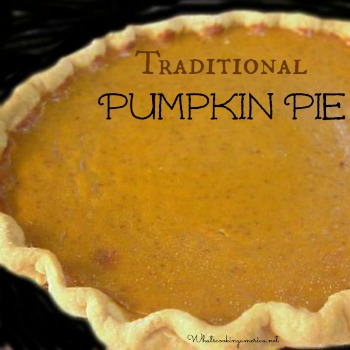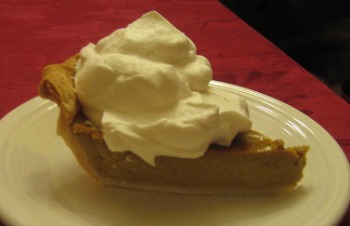1621 – Early American settlers of Plimoth Plantation (1620-1692), the first permanent European settlement in southern New England, might have made pumpkin pies (of sorts) by making stewed pumpkins or by filling a hollowed out shell with milk, honey and spices, and then baking it in hot ashes. An actual present-day pumpkin pie with crust is a myth, as ovens to bake pies were not available in the colony at that stage.
Northeastern Native American tribes grew squash and pumpkins. They roasted or boiled them for eating. Historians think that the settlers were not very impressed by the Indians’ squash and/or pumpkins until they had to survive their first harsh winter when about half of the settlers died from scurvy and exposure. The Native Americans brought pumpkins as gifts to the first settlers, and taught them the many used for the pumpkin. This is what developed into pumpkin pie about 50 years after the first Thanksgiving in America.
The early settlers of Plimoth Plantation brought English cookery and possibly some English cookbooks with them to the new world. The present day historians of Plimoth Plantation don’t really know what cookbooks, if any, were owned by the 17th century settlers.
1651 – Francois Pierre la Varenne, the famous French chef and author of one of the most important French cookbooks of the 17th century, wrote a cookbook called Le Vrai Cuisinier Francois (The True French Cook). It was translated and published in England as The French Cook in 1653. It has a recipe for a pumpkin pie that included the pastry:
Tourte of pumpkin – Boile it with good milk, pass it through a straining pan very thick, and mix it with sugar, butter, a little salt and if you will, a few stamped almonds; let all be very thin. Put it in your sheet of paste; bake it. After it is baked, besprinkle it with sugar and serve.
1670s – By the 1670’s, recipes for a sort of “pumpion pie” were appearing in such English cookbooks as the The Queen-like closet, or rich cabinet stored with all manner of rare receipts for preserving, candying and cookery by Hannah Wooley and The Compleat Cook – Expertly Prescribing the Most Ready Wayes, Whether Italian, Spanish or French, for Dressing of Flesh and Fish, Ordering Of Sauces or Making of Pastry by W.M.
1670 – The Queen-like Closet by Hannah Wooley:
To make a Pumpion-Pie – Take a Pumpion, pare it, and cut it in thin slices, dip it in beaten Eggs and Herbs shred small, and fry it till it be enough, then lay it into a Pie with Butter, Raisins, Currans, Sugar and Sack, and in the bottom some sharp Apples, when it is baked, butter it and serve it in.
1671 – The Compleat Cook by W.M:
Pumpion Pie – Take about halfe a pound of Pumpion and slice it, a handfull of Tyme, a little Rosemary, Parsley and sweet Marjoram slipped off the stalks, and chop them smal, then take Cinamon, Nutmeg, Pepper, and six Cloves, and beat them; take ten Eggs and beat them; then mix them, and beat them altogether, and put in as much Sugar as you think fit, then fry them like a froiz; after it is fryed, let it stand till it be cold, then fill your Pye, take sliced Apples thinne round wayes, and lay a row of the Froiz, and a layer of Apples with Currans betwixt the layer while your Pye is fitted, and put in a good deal of sweet butter before you close it; when the Pye is baked, take six yolks of Eggs, some white-wine or Verjuyce, & make a Caudle of this, but not too thick; cut up the Lid and put it in, stir them well together whilst the Eggs and Pumpions be not perceived, and so serve it up.
1796 – It was not until 1796 that a truly American cookbook, American cookery, by an American orphan by Amelia Simmons, was published. It was the first American cookbook written and published in America, and the first cook book that developed recipes for foods native to America. Her pumpkin puddings were baked in a crust and similar to present day pumpkin pies:
Pompkin Pudding No. 1. One quart stewed and strained, 3 pints cream, 9 beaten eggs, sugar, mace, nutmeg and ginger, laid into paste No. 7 or 3, and with a dough spur, cross and chequer it, and baked in dishes three quarters of an hour.
Pompkin Pudding No. 2. One quart of milk, 1 pint pompkin, 4 eggs, molasses, allspice and ginger in a crust, bake 1 hour.
Categories:
American Regional Foods Christmas Food History Holiday Turkey Dinners Pumpkin Pies Thanksgiving


4 Responses to “Pumpkin Pie History”
Kate Sheehan
Hi there!
I am the PR manager at Plimoth Plantation. I came across this article and the section on the 1620s has a couple of historical inaccuracies we’d love to help with since we are mentioned. Please email ksheehan@plimoth.org and we can have you chat with one of our foodways historians.
Thank you!
Nancy
Kate, I sent you an email and didn’t hear back from you or lost your response. We would love to have your input on the the history please send it to me and we will update our page.
Quin
“… by making stewed pumpkins or by filling a hollowed out shell with milk, honey and spices, and then baking it in hot ashes. An actual present-day pumpkin pie with crust is a myth, as ovens to bake pies were not available in the colony at that stage.”
Would you please share the source for this information? I work at a museum doing living history, and I run the Victorian kitchen. I’d LOVE to find documentation for this technique in a primary source in or before my period. Thanks!
Jenn
Quin they actually did have ovens. We visited the living pilgrim museum, in some of the homes there were clay ovens for baking corn bread, they could have easily baked a pie in there with the proper clay or iron vessel atop the wood ashes. The crust may have been difficult however as for grain they mainly only had corn at first.